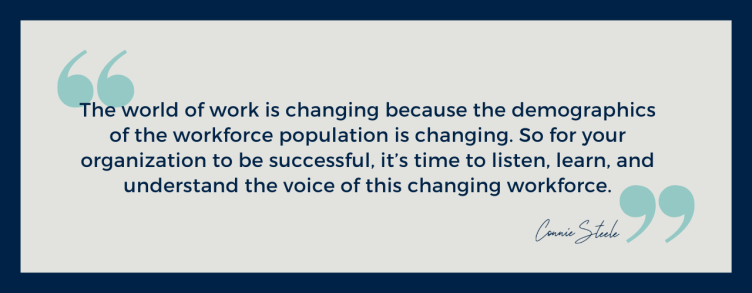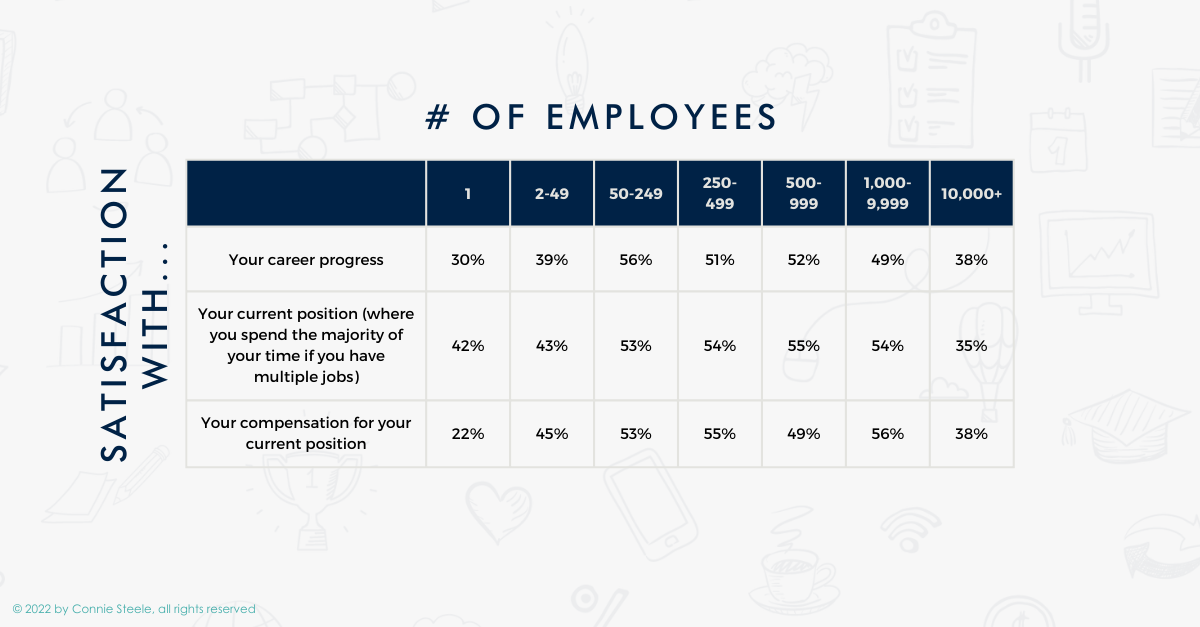Solo, SMB, or Enterprise: What Organizations Are Best at Nurturing Highly Successful People?
The composition of the workforce is changing.
The workforce is getting younger. The workforce is getting more diverse. The workforce has different goals, priorities, and attitudes than they did just 10 years ago. And I believe these changes are driving what the Future of Work will look like.
But what organizations are best equipped to support the workforce of today (and tomorrow)?
Overall, when looking at responses from The State of Work and Career Success 2022, we saw that those who work in small- to mid-sized organizations (from 50 employees to 9,999 employees) are most satisfied with their progress, position, and compensation. Those in businesses of 1-49 or enterprise-scale businesses (10,000 or more employees) feel significantly less satisfied, by comparison.
When we dove deeper into how successful these workers were feeling, we saw a similar pattern. In particular, those who are employed in very large companies (10,000+ employees) have the greatest percentage of workers who feel unsuccessful (36% vs. 23% on average).
Listening to the Voice of the Workforce
I think this relationship between company size and career success is primarily driven by two factors:
One, workers who are employed in small- and medium-size organizations skew younger and are more diverse. This mirrors the demographics of highly successful workers overall, which I wrote about in my July column. And it just so happens that this is the future of the workforce. In contrast, those who are employed by very large companies (10000+ employees) skew older and less ethnically diverse.
Two, those who work in companies with one to 49 employees and at very large enterprise-level organizations may not have the organizational support that people need to feel successful in a world that is collaborative, broad, agile, and fluid. Smaller organizations likely just don’t have the necessary resources, people, or processes. Larger organizations are often too siloed, hierarchical, and rigid to adapt.
The Downside of Working at Large Organizations
While there are undoubtedly some benefits to working in very large organizations, our research showed that career satisfaction is not among them. They are also the least successful in the activities that have the greatest influence on their satisfaction with career progress overall:
Setting specific career goals with a plan to achieve them
Having a mentor who will meet with you regularly to discuss your career
Having a career sponsor (someone in your organization who is not your boss) advocating for you
To find people-company fit, it requires looking at all facets of who the worker is, what environment they work best in, and whether there is fundamental alignment between the goals and objectives of the company and the people who work for them.
To that end, there’s also been a lot of talk about DE&I for the last decade or so, with renewed fervor after 2020, but things aren’t improving very quickly. While there’s been a lot of movement to diversify boards and leadership levels, changes to the workforce itself, particularly at large companies, is lagging. Again, a lot of this is structural: U.S. workers told us they feel less successful in ‘getting leadership experience’ and ‘being treated fairly and equitably’ in these organizations; the Economic Policy Institute reports that there is still a significant wage gap; and according to data on the S&P 500 from Mercer in 2020, “64% of workers in entry level positions are white. In the top executive ranks, however, 85% of positions are held by whites, demonstrating the promotion gap that minorities face.”
Companies engage in ‘voice of the customer’ programs and research so that they can better understand and meet the needs and expectations of their target audience. Leadership recognizes that they have to develop an intimate understanding of their target audience if they want to improve the products and services they offer, but these tactics are rarely leveraged to improve the experience of employees — the people who make up the brains and building blocks of any organization.
The world of work is changing because the demographics of the workforce population is changing. And along with that, so are their attitudes, beliefs, motivations, and approaches. What they want, what they need, and the paths they take to find success aren’t the same as they were even a few years ago. So for your organization to be successful, it’s time to listen, learn, and understand the voice of this changing workforce. Only then can you determine how your organization can structurally and operationally adapt and adjust to identify what works for your people AND your business.
If you’re interested in putting your finger on the pulse of your team members to find out how you can better support them, please don’t hesitate to reach out or connect with me on LinkedIn.
This article was originally published on LinkedIn as part of Connie Steele’s monthly newsletter, The Human Side of Work. You can find the original article and subscribe to the newsletter at https://www.linkedin.com/pulse/solo-smb-enterprise-what-organizations-best-nurturing-wang-steele.


